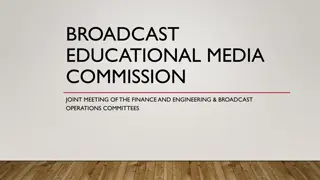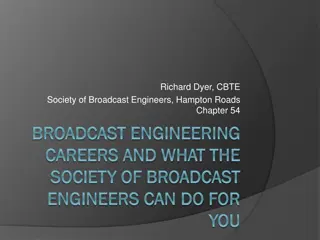Understanding Broadcast Television and Radio: A Comprehensive Course Overview
This course delves into the history, contemporary forms, and impact of broadcast television and radio, exploring academic approaches, traditions, and critical orientations in the field. Students will analyze ownership structures, audience dynamics, regulatory frameworks, and content production in national and global contexts. The course also emphasizes group work, individual assignments, and presentations to enhance learning outcomes.
Download Presentation

Please find below an Image/Link to download the presentation.
The content on the website is provided AS IS for your information and personal use only. It may not be sold, licensed, or shared on other websites without obtaining consent from the author. Download presentation by click this link. If you encounter any issues during the download, it is possible that the publisher has removed the file from their server.
E N D
Presentation Transcript
Course Outline Let s start with the first set of slides 1 Module Name: BASIC TV BROADCASING Module code JST 04201
1. Been introduced to academic approaches to broadcast television and radio. 2. Gained familiarity with traditions of broadcast studies including the key literature and language used. 3. Developed a historical and critical orientation to studies of contemporary television and radio institutions 4. providing understandings of the origins and legacies of antecedents like the telegraph, film and photography. 5. Demonstrate a general awareness of the role of broadcast television and radio in understanding social life. 2
This course examines the history and contemporary forms of broadcast television and radio, and develops an understanding of the impact of digitization, which students gained in the introductory media course, Digital Revolutions. It compares public, commercial, and community models of broadcast media organizations by examining ownership and the range of audiences, styles, formats and the content typical of each institution. National broadcast regulation and policy-making is considered in relation to the forming or sustaining of communities. The course considers the production, reception and distribution of broadcast content, nationally, and globally with reference to format trade 3
Assignment,....4 Group work .. .1 Individual works 2 Presentation ..2 4
Gilbert, Sean; Nelson, John; Jacobs, George, World Radio TV Handbook 2007, Watson- Guptill, 2006. ISBN 0-9535864-9-9. The 2007 edition of the World Radio TV Handbook. Wells, Alan, World Broadcasting: A Comparative View, Greenwood Publishing Group, 1996. ISBN 1-56750-245-8 5
END EXAMS MARKS This examination shall be conducted for a duration not exceeding three (3) hours, but not less than two (2) hours. End of module examination could cover both theory and practical but should be done under supervision of institute s official assessors. The end of semester exam will constitute 40% while continuous assessment will constitute 60%. CONTINOUSLY ASSESSMENT ASSESSMENT TEST QUIZ INDIVIDULA ASSIGNMENT GROUP WORK 6
THANKS! Any questions? 7























